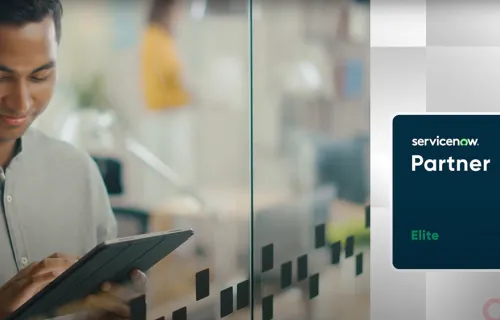In this interview, David Tierno, CGI’s Vice President of Strategic Alliances, shares key insights on the growing importance of strategic alliances across sectors, as organizations seek new capabilities and opportunities to drive performance and growth.
President of Strategic Alliances
Organizations across industries are expanding their ecosystems to drive innovation, as well as new products, services and revenue streams. CGI’s latest Voice of Our Clients research confirms this, with nearly 70% of executives interviewed partnering with technology companies or creating business partnerships. In your view, why are strategic alliances more important today than ever?
David: Strategic alliances always have been important, but their importance is increasing as industries evolve. Organizations are competing today in highly dynamic markets in which customers, citizens and other stakeholders have fast-evolving expectations that demand innovation and digitization. This pace of change requires organizations to be equally dynamic and agile. Pivoting, however, in response to change can be a major challenge.
One way to address this challenge is through partnerships. By building a strong ecosystem, organizations can tap into the knowledge, skills and solutions of partners that are close to market changes and, in fact, may be driving some of them. They can take advantage of partner capabilities while, at the same time, focusing internally on culture and change management, including re-skilling and training, and other strategic initiatives, such as market expansion, to increase their business agility.
As more organization pursue strategic alliances, what should they keep in mind to find the best partners?
David: To build an effective strategic alliance, find a point of synergy with a partner that enables you to drive market differentiation. At the end of the day, an organization’s partnerships should stand out to its customers, demonstrating unique perspectives and complementary capabilities that its competition can’t offer. To achieve this level of synergy, an organization should select partners that align with the markets in which it competes, the customers (or citizens) it serves, and the capabilities it needs—now and in the future.
It also should look for partners that are shaping the new markets it wants to pursue, as well as new high demand areas such as sustainability. I always use the analogy of a hockey puck. You want to go where the puck is headed, not where it is right now. Identify and align with a partner that is setting the direction in a new market, and choose to move forward with that partner.
What are some key trends clients face that demand the support of strategic alliances?
David: As I mentioned above, the pace of change is a major force in today’s business world, driving many new trends. Take, for example, cloud computing. First there was the general move toward cloud computing, and then we witnessed the evolution of different types of cloud services delivery—from private, to public, to hybrid, to multi-cloud. As this evolution progresses, organizations require partners that can help them navigate the changes, migrate to the cloud effectively, and seamlessly move from one cloud environment to another.
Sustainability and the advent of 5G are two additional examples. Managing cross-industry trends like these requires collaboration with partners that understand their full impact and how these trends can help our clients grow and succeed.
Overall, whatever the trend, working with partners can help organizations be nimble and adapt, while taking advantage of new capabilities that create new business opportunities.
What is CGI’s approach to building strategic alliances? How does CGI balance its work with partners with its commitment to remaining technology agnostic?
David: First, I think it’s helpful to share how CGI defines “strategic alliance.” In our view, a strategic alliance is global in scope, aligned with our core service offerings and focus industries, and best positioned to drive growth for both CGI and our partners. Today, we have nine strategic alliances: Microsoft, AWS, Google, SAP, Salesforce, ServiceNow, UIPath, Blue Prism and Automation Anywhere.
At our core, we’re client-centric with a metro market model that enables us to live and work in close proximity to our clients. We adhere firmly to the principle of objectivity when it comes to meeting our clients’ needs. We never approach a client with a preconceived position or approach, nor do we ever force a partnership.
In alignment with these principles, our clients expect us to deliver the skills and capabilities they require to address industry change, shape their future, and increase their competitiveness. To meet this expectation, we choose partners that align with our clients’ industry trends, as well as their business and IT priorities.
We build partnerships that give us a unique point of view, proven expertise and innovative solutions directly related to our clients’ business goals. For example, if a client wants to move not just to the cloud, but to Microsoft Azure, then we’re in a position, as a Microsoft Gold Partner, to help them to successfully achieve that goal. Another example is our work with a Canadian telecommunications company to migrate its SAP core business systems to the cloud. We partnered with Google (in the capacity of a Google Cloud Partner), SAP Canada, and oXya (a subsidiary of Hitachi) to develop a best-fit cloud migration path for the company.
Ultimately, our partnerships are driven by client preference, aligned with client goals, and managed in a way that helps clients respond quickly and competitively to change.
You joined CGI with extensive experience in helping organizations build effective strategic alliances. What drew you to CGI? What new opportunities did you see?
David: I’ve spent the last 20 years focused in one capacity or another on building strategic alliances. What drew me to CGI was its ongoing commitment to strengthening its investment and go-to-market approach in partnerships. Partnerships always have been a core focus, strategic imperative, and growth enabler for CGI, but I saw an opportunity to help further develop our partnership strategy, structure and solutions.
Since joining CGI, I’ve enjoyed the best of both worlds. A company with tremendous market presence, great clients and excellent capabilities, as well as a company with strong partnerships. My team and I focus each day to accelerate the value our partnerships deliver to clients, which brings tremendous satisfaction.





